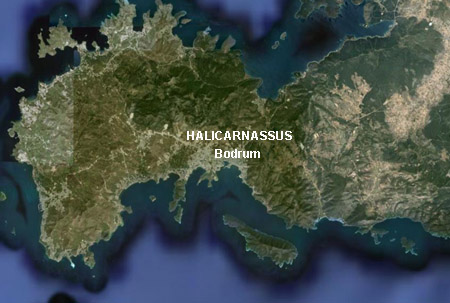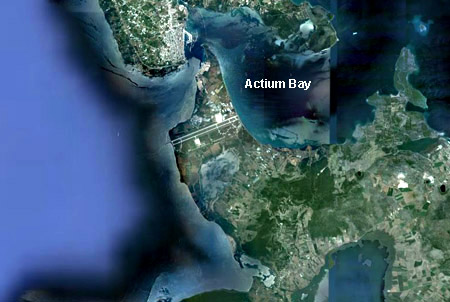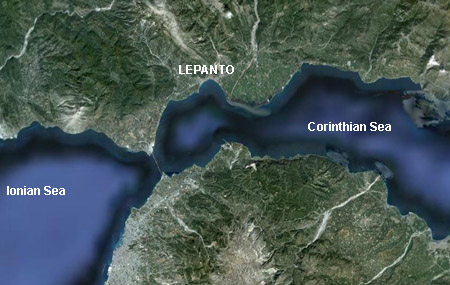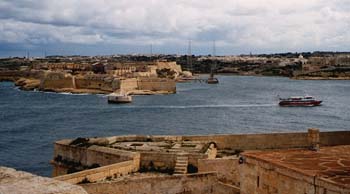| Page 1 |
Great
Ancient Naval Battles of the Mediterranean |
For several millenium the Mediterranean has been theatre to many great battles at sea, sieges of coastal towns and simple acts of piracy, plunder and rape. The cruising sailor can enrichen his travels by learning the local history of his troubled past and thus pay homage to the many persons who gave their lives to make the world as we know it today. Had Greece not succeeded in defeating the Persians, its culture may not have reached the greatness that it did; had the Ottomans not been defeated at Lepanto and at Malta, Western culture and our very languages would have been very much different today.
Below are some of the battle sites the cruising sailor will encounter while navigating the Med, where he should take a moment to ponder on the innumerable watery graves and sunken gallies that lie peacefully in the depths below his keel.
The Trojan War - 12th Century BC
Greek mythology tells of a war waged against the city of Troy (now in Turkey) by the Achaeans (Greeks) after Paris of Troy took Helen from her husband Menelaus, the king of Sparta. The city was originally a coastal town, but the coastline has since retreated, leaving the ruins of Troy several kilometres inland.
They besieged the city for ten years and finally it fell to the ruse of the Trojan Horse. Aeneas, one of the surviving Trojans is supposed to have fled and ended up founding the city of Rome.
![]()
The Battle of Athens - 480 BC
A politician and
general, Themistoclese advocated a strong Athenian navy, and in 483 BC he
persuaded the Athenians to build a fleet of 100 triremes, which would
prove crucial in the forthcoming conflict with Persia. Threatened by
Xerxes' vast Persian army, the Athenians sent to the Oracle at Delphi
enquiring about the inevitable confrontation and the news they got back
was devastating, "'Why sit you doomed one? Fly to the ends of the
earth. All is ruin for fire and the headlong god of war shall bring you
low." Near panic, the Athenians asked for a subsequent message.
The Oracle replied cryptically, "'Though all else shall be taken,
Zeus, the all seeing, grants that the wooden wall only shall not
fail." Conflict over interpretation ensued, but it was Themistocles
who prevailed. He convinced his fellow Athenians that their "wooden
wall" was their fleet of triremes, ships that had been built at his
emphatic suggestion. He then convinced the Athenians to evacuate Athens.
So over 100,000 Athenians fled and when the Persians arrived they found an
abandoned city and put it to fire. Themistocles then sent a messenger to
Xerxes telling him that the Greeks were intent on escape and that if he
acted quickly he could destroy them. He "took the bait."
As Xerxes watched from shore, his fleet that had entered the narrow
channel between Salamis and the Greek mainland in the dark of night, and
he thought "undetected," was attacked. The Athenian triremes
(much more manoeuvrable in the narrows) soundly defeated the Persians. It
was reported that while the Persians lost more than 200 ships, the
Athenians lost only 40. Persia's ally Egypt had sent a fleet to try to cut
off the supposedly fleeing Greeks, but a Corinthian fleet
"handled" the Egyptians. Unable to supply his army, it was now
Xerxes turn to flee. (Cleisthenese)
![]()
The Siege of Halicarnassus (Bodrum) - 334 BC

Alexander the Great, who had no navy, was constantly being threatened by the Persian navy. It continuously attempted to provoke an engagement with Alexander, who always avoided it. Eventually, the Persian fleet sailed to Halicarnassus (now Bodrum in Turkey), in order to establish a new defense there, so Alexander sent his army south to confront the Persians.
Alexander's army captured the city and the Persians following the order of their king, in their retreat destroyed the whole city by fire, except for the monumental tomb of king Mausolos (origin of the word mausoleum).
![]()
The Battle of Carthage - the Third Punic War - 149 BC
After two previous Punic wars, a young Roman consul, Scipio, finally defeated the Carthaginians in a field battle, besieged the city, constructing a mole to block the circular inner harbor. After the victory, the Romans ordered all the populace to leave the city while they razed it to the ground: "Cartago delecta est" was the official report to Rome (Carthage hs been deleted). This put an end to a long rein of the descendants of the Phoenecians over all the Western Mediterranean and a new dominance of the Roman Empire over what they can now truthfully call "Mare nostrum" (Our sea).
![]()
The Battle of Actium - 21 BC


Mark Antony and Cleopatra had set off from Alexandria with 500 ships to attack Rome, but were forced to take refuge from a storm at Actium, a convenient safe harbour in Greece on the Ionian Sea. Octavian got word of their arrival and advanced south from his base in Corfu with his 400 ships and managed to defeat Mark Antony, while Cleopatra fled back to Egypt with her treasure laden ship. The sad epilogue to this conniving romance was suicide for both Mark Antony and Cleopatra.
This last naval battle of the Roman Republic definitively established Octavian as the sole ruler over Rome and of the Mediterranean world.
![]()
The Siege of Rhodes - 1522
This was the second and ultimately successful attempt by the Ottoman Empire, Suleyman the magnificent, to expel the Knights of Rhodes from their island stronghold and thereby secure Ottoman control of the Eastern Mediterranean. They consequently abandoned their other stronghold at the castle of Bodrum and retreated to Malta.
During the 16th century, a native of Caria Region, Turgut Reis raised to one of the highest ranks in the Ottoman Navy and became one of the captains of Barbarossa. His fame as Dragut spread all over the Mediterranean world, a viscious pirate who terrorised much of the Mediterranean, including Sardinia. His home-town in Turkey now honours his name "Turgutries", not far from Bodrum.
![]()
The Conquest of Tunis - 1535
Piracy was considered fair game by everyone and was rife throughout the Mediterranean. A champion at this sport was Barbarossa, (Khair ad-Din) and his brothers, who in only three years from 1512, had captured as many as 56 ships! All crewman surviving the assault were made oar salves.
In 1534 Barbarossa, had ousted the local pro-Spainish ruler of Tunis, and established a strong naval base there, to be used for his raids in Spain Sardinia, Sicily, mainland Italy and Malta. There was hardly a coastal town in Sardinia and mainland Italy that hadn't been sacked at some time or another.
Barbarossa's galley in 1543
To put an end to this critical land base in Tunis, Charles V of Spain set off with 300 galleys and 24,000 soldiers, made a supply stop-over in Malfatano bay, south of Cagliari, Sardinia, then stormed Tunis, which was quickly abandoned by Barbarossa. Undeterred, he continued to advance his pirating career at the service of the Ottoman Empire, together with his notorious captain Dragut, wreaking havoc on the Italian coasts and in the Greek islands. At one point he operated from his private castle in Capri, which still carries his name today.
Barbarossa (known as Hayreddin Pasha by the English) established Turkish supremacy in the Mediterranean which lasted until the Battle of Lepanto in 1571.
![]()
The Great Siege of Malta - 1565
The Ottoman Empire in mid-May and in overwhelming numbers, attacked the island, held by the Knights of Malta, in one of the bloodiest and most fiercely contested in history, but were defeated. The island's position in the center of the Mediterranean made it a strategically crucial gateway between East and West, so expecting to be attacked sooner or later, the knights strengthened the three formidable fortresses, which proved crucial to their successful resistence.
The Turkish armada arrived with 193 vessels, with a total of 48,000 men, compared with a mere 6000 defenders of Malta.They managed to take fort Saint Elmo, but it cost the Turks 6000 men and Turgut himself.
Queen Elizabeth I expressed the general sentiment in: "If the Turks should prevail against the Isle of Malta, it is uncertain what further peril might follow to the rest of Christendom".
By September the weather was turning and the Turks prepared to abandon the siege and were hurried on with the arrival of help from the mainland. Malta survived the Turkish assault though suffering many losses, enduring bombardment of some 130,000 cannon balls, and throughout Europe people celebrated the last epic battle of the Crusader Knights, which halted Turkish encroachment in Europe.
![]()
The Battle of Lepanto - October 1571

The Ottoman forces, of 278 vessels and 47,000 hands, sailing westwards from their naval station in Lepanto, Navpaktos, met the Holy League forces, coming from Messina, with their 212 ships and 41,000 men. The Christians had a superior armamaents, guns and cannons.
Some heavy artillery galleasses had been towed half a mile ahead of the Christian line. When the battle started, the Turks mistook the Galleasses to be merchant supply vessels and set out to attack them. This proved to be disastrous, as the galleasses, with their many guns, alone were said to have sunk up to 70 Ottoman galleys. The Spaniards managed to storm the Turks comander's ship and kill their leader, Ali Pasha, which contributed to destroy the Turkish morale. The battle turned against the Turks and they started to run out of weapons and lost 210 ships. The Christians had lost 50 ships.
This major decisive victory protected Italy
from further Ottoman invasion, heralded the end of Turkish supremacy in the
Mediterranean and prevented the Ottomans from advancing
westwards towards Europe.
<<< BACK
The Mediterranean Sea
mediterranean-yachting.com
Copyright L. Camillo
2011
